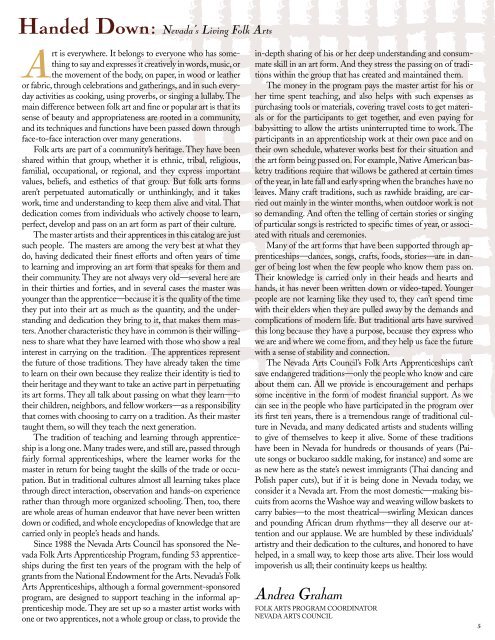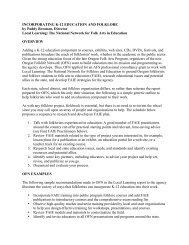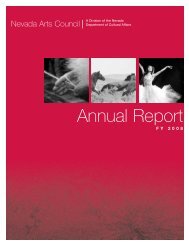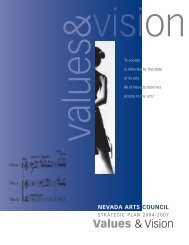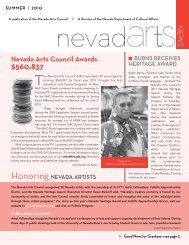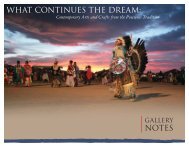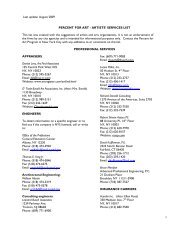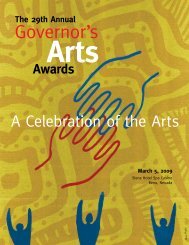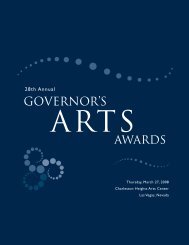Handed Down - Nevada Arts Council
Handed Down - Nevada Arts Council
Handed Down - Nevada Arts Council
Create successful ePaper yourself
Turn your PDF publications into a flip-book with our unique Google optimized e-Paper software.
<strong>Handed</strong> <strong>Down</strong>: <strong>Nevada</strong>’s Living Folk <strong>Arts</strong><br />
Art is everywhere. It belongs to everyone who has something<br />
to say and expresses it creatively in words, music, or<br />
the movement of the body, on paper, in wood or leather<br />
or fabric, through celebrations and gatherings, and in such everyday<br />
activities as cooking, using proverbs, or singing a lullaby. The<br />
main difference between folk art and fine or popular art is that its<br />
sense of beauty and appropriateness are rooted in a community,<br />
and its techniques and functions have been passed down through<br />
face-to-face interaction over many generations.<br />
Folk arts are part of a community’s heritage. They have been<br />
shared within that group, whether it is ethnic, tribal, religious,<br />
familial, occupational, or regional, and they express important<br />
values, beliefs, and esthetics of that group. But folk arts forms<br />
aren’t perpetuated automatically or unthinkingly, and it takes<br />
work, time and understanding to keep them alive and vital. That<br />
dedication comes from individuals who actively choose to learn,<br />
perfect, develop and pass on an art form as part of their culture.<br />
The master artists and their apprentices in this catalog are just<br />
such people. The masters are among the very best at what they<br />
do, having dedicated their finest efforts and often years of time<br />
to learning and improving an art form that speaks for them and<br />
their community. They are not always very old—several here are<br />
in their thirties and forties, and in several cases the master was<br />
younger than the apprentice—because it is the quality of the time<br />
they put into their art as much as the quantity, and the understanding<br />
and dedication they bring to it, that makes them masters.<br />
Another characteristic they have in common is their willingness<br />
to share what they have learned with those who show a real<br />
interest in carrying on the tradition. The apprentices represent<br />
the future of those traditions. They have already taken the time<br />
to learn on their own because they realize their identity is tied to<br />
their heritage and they want to take an active part in perpetuating<br />
its art forms. They all talk about passing on what they learn—to<br />
their children, neighbors, and fellow workers—as a responsibility<br />
that comes with choosing to carry on a tradition. As their master<br />
taught them, so will they teach the next generation.<br />
The tradition of teaching and learning through apprenticeship<br />
is a long one. Many trades were, and still are, passed through<br />
fairly formal apprenticeships, where the learner works for the<br />
master in return for being taught the skills of the trade or occupation.<br />
But in traditional cultures almost all learning takes place<br />
through direct interaction, observation and hands-on experience<br />
rather than through more organized schooling. Then, too, there<br />
are whole areas of human endeavor that have never been written<br />
down or codified, and whole encyclopedias of knowledge that are<br />
carried only in people’s heads and hands.<br />
Since 1988 the <strong>Nevada</strong> <strong>Arts</strong> <strong>Council</strong> has sponsored the <strong>Nevada</strong><br />
Folk <strong>Arts</strong> Apprenticeship Program, funding 53 apprenticeships<br />
during the first ten years of the program with the help of<br />
grants from the National Endowment for the <strong>Arts</strong>. <strong>Nevada</strong>’s Folk<br />
<strong>Arts</strong> Apprenticeships, although a formal government-sponsored<br />
program, are designed to support teaching in the informal apprenticeship<br />
mode. They are set up so a master artist works with<br />
one or two apprentices, not a whole group or class, to provide the<br />
in-depth sharing of his or her deep understanding and consummate<br />
skill in an art form. And they stress the passing on of traditions<br />
within the group that has created and maintained them.<br />
The money in the program pays the master artist for his or<br />
her time spent teaching, and also helps with such expenses as<br />
purchasing tools or materials, covering travel costs to get materials<br />
or for the participants to get together, and even paying for<br />
babysitting to allow the artists uninterrupted time to work. The<br />
participants in an apprenticeship work at their own pace and on<br />
their own schedule, whatever works best for their situation and<br />
the art form being passed on. For example, Native American basketry<br />
traditions require that willows be gathered at certain times<br />
of the year, in late fall and early spring when the branches have no<br />
leaves. Many craft traditions, such as rawhide braiding, are carried<br />
out mainly in the winter months, when outdoor work is not<br />
so demanding. And often the telling of certain stories or singing<br />
of particular songs is restricted to specific times of year, or associated<br />
with rituals and ceremonies.<br />
Many of the art forms that have been supported through apprenticeships—dances,<br />
songs, crafts, foods, stories—are in danger<br />
of being lost when the few people who know them pass on.<br />
Their knowledge is carried only in their heads and hearts and<br />
hands, it has never been written down or video-taped. Younger<br />
people are not learning like they used to, they can’t spend time<br />
with their elders when they are pulled away by the demands and<br />
complications of modern life. But traditional arts have survived<br />
this long because they have a purpose, because they express who<br />
we are and where we come from, and they help us face the future<br />
with a sense of stability and connection.<br />
The <strong>Nevada</strong> <strong>Arts</strong> <strong>Council</strong>’s Folk <strong>Arts</strong> Apprenticeships can’t<br />
save endangered traditions—only the people who know and care<br />
about them can. All we provide is encouragement and perhaps<br />
some incentive in the form of modest financial support. As we<br />
can see in the people who have participated in the program over<br />
its first ten years, there is a tremendous range of traditional culture<br />
in <strong>Nevada</strong>, and many dedicated artists and students willing<br />
to give of themselves to keep it alive. Some of these traditions<br />
have been in <strong>Nevada</strong> for hundreds or thousands of years (Paiute<br />
songs or buckaroo saddle making, for instance) and some are<br />
as new here as the state’s newest immigrants (Thai dancing and<br />
Polish paper cuts), but if it is being done in <strong>Nevada</strong> today, we<br />
consider it a <strong>Nevada</strong> art. From the most domestic—making biscuits<br />
from acorns the Washoe way and weaving willow baskets to<br />
carry babies—to the most theatrical—swirling Mexican dances<br />
and pounding African drum rhythms—they all deserve our attention<br />
and our applause. We are humbled by these individuals’<br />
artistry and their dedication to the cultures, and honored to have<br />
helped, in a small way, to keep those arts alive. Their loss would<br />
impoverish us all; their continuity keeps us healthy.<br />
Andrea Graham<br />
Folk <strong>Arts</strong> Program Coordinator<br />
<strong>Nevada</strong> <strong>Arts</strong> <strong>Council</strong><br />
5


